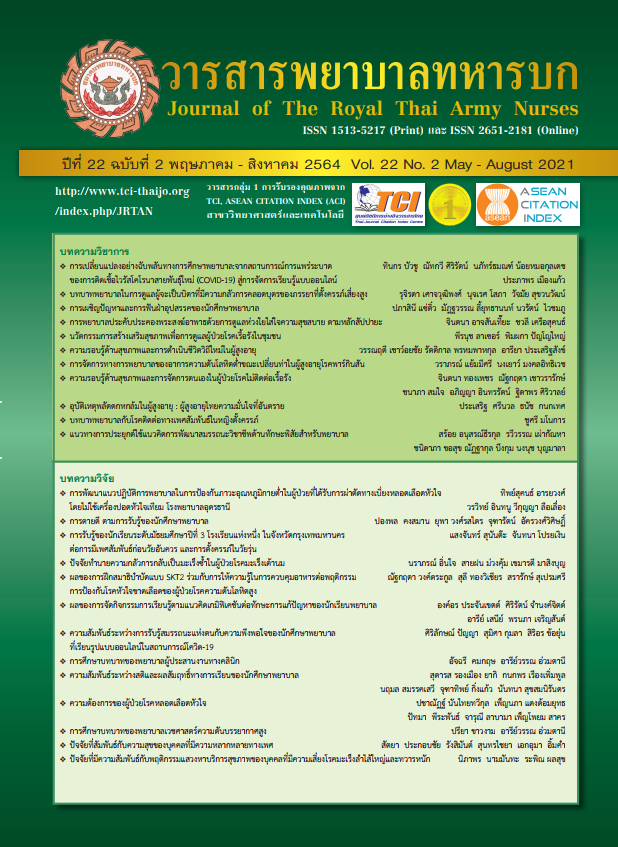The Effect of Information Giving Through Two-Dimension Cartoon Animation on Preventive Behavior for Acute Respiratory Tract Infection among Preschoolers in Childcare Centers
Keywords:
2D cartoon animation, preventive behavior, respiratory tract infection, preschooler, childcare centerAbstract
The research purpose was to investigate the effect of information giving through two-dimension cartoon animation on preventive behavior for acute respiratory tract infection (ARIs) among preschoolers in childcare centers. Subjects consisted of 47 preschoolers in a child development center under the Supervision of Local Administration, aged between 3-5 years. Twenty two preschoolers were in the experimental group and 25 were in the control group. Research instruments included the information given by two-dimension cartoon animation which was guided by Edutainment Animated Series for Children of Isa, the knowledge test and the behavioral observation form of preventive behavior for ARIs. Data were analyzed using descriptive statistics and t-test. The major results are as follows: 1. The mean score of preventive behavior for ARI among preschoolers after receiving information given by two-dimension cartoon animation was better than that before receiving information given through two-dimension cartoon animation at a significant level of .05. 2. The mean difference score of preventive behavior for acute respiratory tract infection among preschoolers in the group receiving information given by two-dimension cartoon animation was better than that in the group receiving routine care at a significant level of .05.
Downloads
References
Alexandrino AS, Santos R, Melo C, Bastos JM. Risk factors for respiratory infections amongchildren attending day care centres. FamPract.2016; 33(2): 161–6.
Krishnan A, Amarchand R, Gupta V, Lafond KE, Suliankatchi RA, Saha S, et al. A epidemiology of acute respiratory infections in children - preliminary results of a cohort in a rural north Indian community. BMC infectious diseases. 2015;15:462-71.
Bureau of Epidemiology. Influenza situation in Thailand: National Trustworthy and Competent Authority in Epidemiological Surveillance and investigation; 2016. (inThai)
Arusonthi P. The study of social support, resource and health care seeking behavior in parents of Children with acute respiratory infection age 1-5 years. JRTAN. 2016;17(1): 132-40. (inThai)
Division of Communicable Disease. Disease screening report healthy preschool: Department of Disease Control, MOPH, Thailand; 2016 (inThai)
Bhudhisawasdi K, Leelasethe T, TeeratakulpisarnJ. Natural history of the common cold with respect to day-care attendance at a university hospital in KhonKaen, Thailand. SRIMEDJ.2009;24:260-4.(inThai)
Prayoonmahisorn S. Development of self learning package for infection prevention among child care providers in child development center. Nursing Journal. 2013;40:34-44.(inThai)
American Academy of Pediatrics. Influenza prevention and control: strategies for early education and child care programs. Organization. 2015.
Department of Disease Control. Guidelines for the prevention and control of communicable diseases in childcare centers (for teacher and caretaker). 2nded. Bureau of General Communicable Disease, Department of Disease Control; 2011.(inThai)
Tondare MB, Raje VV, Mumbare S, Rayate MV, Tondare S, Kakade SV. Acute respiratory tract infection among preschool children in Western Maharashtra, India. AJMS.2014;5(4):34–8.
Osterholm MT. Infectious disease in child day care: an overview. Pediatrics 1994;6(Pt2):987-90.
Rungamornrat S, Payakkaraung S. Child health management of teachers and caregivers in a child care center under the supervision of local administration in central region of Thailand. J Nurs Sci. 2013; 31(suppl2):77-87. (in Thai)
Hansakunachai T, Pruksananonda C,Chonchaiya W, Benjasuwantep B. Developmental textbooks and child behavior for general practice. Child Development and Behavior Club;2015.(inThai)
Jansong W. The effect of the nursing intervention based on Pender’s health promotion model on infection prevention behaviors in mothers of 1-5-year-old children with cancer undergoing chemotherapy.(thesis). Bangkok: Chulalongkorn University; 2015. (inThai)
Norrasing W. Effect of management for reducing morbidity rate in acute upper respiratory tract infection in Ban Kan Thong kindergarten center Amphure Muang Nakornsithamrat province. (thesis). PathumThani:Walailak University; 2007. (inThai)
Nuttanoo R. The effectiveness of health education program on acute respiratory infection in under 5 year old children of caretakers in Saraburi province.(thesis). Bangkok: Kasetsart University; 2001. (inThai)
Rutchanagul P.the effects of a guideline for caregivers on decreasing the respiratory tract infection rate of children in a child care center. Thai Journal of Science and Technology. 2012;20 (suppl 5):390-404. (in Thai)
Shelov SP, Altmann TR, Hannemann RE, Turbo R. Caring for your baby and young child : birth to age 5. 6th rev.ed. New York: American Academy of Pediatrics; 2014.
Sanongyard J, Dhanawan W,Maungchang Y. The effects of an instructional program using three-dimensional comic book on knowledge about infection control of preschool children. Nursing Journal ofThe Ministry of Public Health.2016;26(2):34-42. (inThai)
Isa WMW, Amin MAM, Rozaimee A, Idris WMRW, Rahim N, Samaden IS. Conceptual framework of edutainment animated series for children: A pious story. ARPN Journal of Engineering and Applied Sciences.2015;10(3):1106–13.
Downloads
Published
How to Cite
Issue
Section
License
บทความหรือข้อคิดเห็นใดใดที่ปรากฏในวารสารพยาบาลทหารบกเป็นวรรณกรรมของผู้เขียน ซึ่งบรรณาธิการหรือสมาคมพยาบาลทหารบก ไม่จำเป็นต้องเห็นด้วย
บทความที่ได้รับการตีพิมพ์เป็นลิขสิทธิ์ของวารสารพยาบาลทหารบก
The ideas and opinions expressed in the Journal of The Royal Thai Army Nurses are those of the authors and not necessarily those
of the editor or Royal Thai Army Nurses Association.






